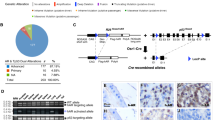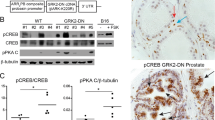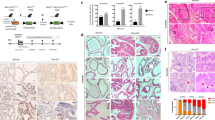Abstract
The transcription factor, early growth response protein 1 (EGR1), is overexpressed in a majority of human prostate cancers and is implicated in the regulation of several genes important for prostate tumor progression. Here we have assessed the effect of Egr1 deficiency on tumor development in two transgenic mouse models of prostate cancer (CR2-T-Ag and TRAMP). Using a combination of high-resolution magnetic resonance imaging and histopathological and survival analyses, we show that tumor progression was significantly impaired in Egr1−/− mice. Tumor initiation and tumor growth rate were not affected by the lack of Egr1; however, Egr1 deficiency significantly delayed the progression from prostatic intra-epithelial neoplasia to invasive carcinoma. These results indicate a unique role for Egr1 in regulating the transition from localized, carcinoma in situ to invasive carcinoma.
This is a preview of subscription content, access via your institution
Access options
Subscribe to this journal
Receive 12 print issues and online access
$209.00 per year
only $17.42 per issue
Buy this article
- Purchase on Springer Link
- Instant access to full article PDF
Prices may be subject to local taxes which are calculated during checkout







Similar content being viewed by others
References
Nagle, R.B., Petein, M., Brawer, M., Bowden, G.T. & Cress, A.E. New relationships between prostatic intra-epithelial neoplasia and prostatic carcinoma. J. Cell. Biochem. Suppl. 26–29 (1992).
Thigpen, A.E. et al. Increased expression of early growth response-1 messenger ribonucleic acid in prostatic adenocarcinoma. J. Urol. 155, 975–981 (1996).
Eid, M.A., Kumar, M.V., Iczkowski, K.A., Bostwick, D.G. & Tindall, D.J. Expression of early growth response genes in human prostate cancer. Cancer Res. 58, 2461–2468 (1998).
Gashler, A. & Sukhatme, V.P. Early growth response protein 1 (Egr-1): prototype of a zinc-finger family of transcription factors. Prog. Nucl. Acid Res. Mol. Biol. 50, 191–224 (1995).
Khachigian, L.M., Lindner, V., Williams, A.J. & Collins, T. Egr-1-induced endothelial gene expression: a common theme in vascular injury. Science 271, 1427–1431 (1996).
Qu, Z. et al. The transcriptional corepressor NAB2 inhibits NGF-induced differentiation of PC12 cells. J. Cell. Biol. 142, 1075–1082 (1998).
Silverman, E.S. & Collins, T. Pathways of Egr-1-mediated gene transcription in vascular biology [comment]. Am. J. Pathol. 154, 665–670 (1999).
Lee, S.L. et al. Luteinizing hormone deficiency and female infertility in mice lacking the transcription factor NGFI-A (Egr-1). Science 273, 1219–1222 (1996).
Russo, M.W., Sevetson, B.R. & Milbrandt, J. Identification of NAB1, a repressor of NGFI-A and Krox20 mediated transcription. Proc. Natl. Acad. Sci. USA 92, 6873–6877 (1995).
Svaren, J. et al. NAB2, a Corepressor of NGFI-A (Egr-1) and Krox20, is induced by proliferative and differentiative stimuli. Mol. Cell. Biol. 16, 3545–3553 (1996).
Miano, J.M. & Berk, B.C. NAB2: a transcriptional brake for activated gene expression in the vessel wall? [comment]. Am. J. Pathol. 155, 1009–1012 (1999).
Svaren, J. et al. EGR1 Target genes in prostate carcinoma cells identified by microarray analysis. J. Biol. Chem. In Press.
Garabedian, E.M., Humphrey, P.A. & Gordon, J.I. A transgenic mouse model of metastatic prostate cancer originating from neuro-endocrine cells. Proc. Natl. Acad. Sci. USA 95, 15382–15387 (1998).
Greenberg, N.M. et al. Prostate cancer in a transgenic mouse. Proc. Natl. Acad. Sci. USA 92, 3439–3443 (1995).
Skobe, M., Rockwell, P., Goldstein, N., Vosseler, S. & Fusenig, N.E. Halting angiogenesis suppresses carcinoma cell invasion. Nature Med. 3, 1222–1227 (1997).
Hojo, M. et al. Cyclosporine induces cancer progression by a cell-autonomous mechanism [comments]. Nature 397, 530–534 (1999).
Pedersen, P.H. et al. Heterogeneous response to the growth factors [EGF, PDGF (bb), TGF-α, bFGF, IL-2] on glioma spheroid growth, migration and invasion. Int. J. Cancer 56, 255–261 (1994).
Klein, K.A. et al. Progression of metastatic human prostate cancer to androgen independence in immunodeficient SCID mice. Nature Med. 3, 402–408 (1997).
Russo, M.W., Matheny, C. & Milbrandt, J. Transcriptional activity of the zinc finger protein NGFI-A is influenced by its interaction with a cellular factor. Mol. Cell. Biol. 13, 6858–6865 (1993).
Barrack, E.R. TGF-β in prostate cancer: a growth inhibitor that can enhance tumorigenicity. Prostate 31, 61–70 (1997).
Fudge, K., Wang, C.Y. & Stearns, M.E. Immunohistochemistry analysis of platelet-derived growth factor A and B chains and platelet-derived growth factor α- and β-receptor expression in benign prostatic hyperplasias and Gleason-graded human prostate adenocarcinomas. Mod. Pathol. 7, 549–554 (1994).
Tourtellotte, W.G., Nagarajan, R., Bartke, A. & Milbrandt, J. Functional compensation by Egr4 in Egr1-dependent luteinizing hormone regulation and Leydig cell steroidogenesis. Mol. Cell. Biol. 20, 5261–5268 (2000).
Ivanovic, V., Melman, A., Davis-Joseph, B., Valcic, M. & Geliebter, J. Elevated plasma levels of TGF-beta 1 in patients with invasive prostate cancer [letter]. Nature Med. 1, 282–284 (1995).
Steiner, M.S. & Barrack, E.R. Transforming growth factor-beta 1 overproduction in prostate cancer: effects on growth in vivo and in vitro. Mol. Endocrinol. 6, 15–25 (1992).
Cui, W. et al. TGF-β1 inhibits the formation of benign skin tumors, but enhances progression to invasive spindle carcinomas in transgenic mice. Cell 86, 531–542 (1996).
Liotta, L.A., Steeg, P.S. & Stetler-Stevenson, W.G. Cancer metastasis and angiogenesis: an imbalance of positive and negative regulation. Cell 64, 327–336 (1991).
Dvorak, H.F. Tumors: wounds that do not heal. Similarities between tumor stroma generation and wound healing. N. Engl. J. Med. 315, 1650–1659 (1986).
Santiago, F.S. et al. New DNA enzyme targeting Egr-1 mRNA inhibits vascular smooth muscle proliferation and regrowth after injury. Nature Med. 5, 1438 (1999).
Riggs, P.K., Rho, O. & DiGiovanni, J. Alteration of Egr-1 mRNA during multistage carcinogenesis in mouse skin. Mol. Carcinog. 27, 247–251 (2000).
Scharnhorst, V. et al. EGR-1 enhances tumor growth and modulates the effect of the Wilms tumor 1 gene products on tumorigenicity. Oncogene 19, 791–800 (2000).
Garabedian, E.M., Roberts, L.J., McNevin, M.S. & Gordon, J.I. Examining the role of Paneth cells in the small intestine by lineage ablation in transgenic mice. J. Biol. Chem. 272, 23729–23740 (1997).
Day, M.L., Fahrner, T.J., Ayken, S. & Milbrandt, J. The zinc finger protein NGFI-A exists in both nuclear and cytoplasmic forms in nerve growth factor-stimulated PC12 Cells. J. Biol. Chem. 265, 15253–15260 (1990).
Kirsch, K.H., Korradi, Y. & Johnson, J.P. Mader: a novel nuclear protein over expressed in human melanomas. Oncogene 12, 963–971 (1996).
McNeal, J.E. & Bostwick, D.G. Intraductal dysplasia: a premalignant lesion of the prostate. Hum. Pathol. 17, 64–71 (1986).
Lee, S.L., Wang, Y. & Milbrandt, J. Unimpaired macrophage differentiation and activation in mice lacking the zinc finger transplantation factor NGFI-A (EGR1). Mol. Cell. Biol. 16, 4566–4572 (1996).
Morrison, T.B., Weis, J.J. & Wittwer, C.T. Quantification of low-copy transcripts by continuous SYBR Green I monitoring during amplification. Biotechniques 24, 954–962 (1998).
Acknowledgements
We thank N. Greenberg for TRAMP mice and G. Gavrilina , T. Gorodinsky, S. Audrain and C. Bollinger for technical assistance. This work was supported by NIH grants 5 P01 CA49712-08 (J.M.), R24 CA83060 (J.J.A.H.)and by grants from The Association for the Cure of Cancer of the Prostate (J.M.). S.A.A. was supported by NIH grants 5 T32CA09547-13 and 1KO8CA8790101.
Author information
Authors and Affiliations
Corresponding author
Rights and permissions
About this article
Cite this article
Abdulkadir, S., Qu, Z., Garabedian, E. et al. Impaired prostate tumorigenesis in Egr1-deficient mice. Nat Med 7, 101–107 (2001). https://doi.org/10.1038/83231
Received:
Accepted:
Issue Date:
DOI: https://doi.org/10.1038/83231
This article is cited by
-
EGR1 regulates angiogenic and osteoclastogenic factors in prostate cancer and promotes metastasis
Oncogene (2019)
-
Spatial maps of prostate cancer transcriptomes reveal an unexplored landscape of heterogeneity
Nature Communications (2018)
-
Egr-1 regulates irradiation-induced autophagy through Atg4B to promote radioresistance in hepatocellular carcinoma cells
Oncogenesis (2017)
-
EGR1 regulates hepatic clock gene amplitude by activating Per1 transcription
Scientific Reports (2015)
-
Egr-1 mediates epidermal growth factor-induced downregulation of E-cadherin expression via Slug in human ovarian cancer cells
Oncogene (2013)



